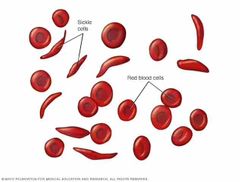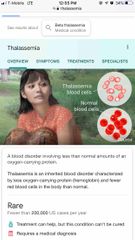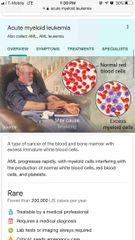![]()
![]()
![]()
Use LEFT and RIGHT arrow keys to navigate between flashcards;
Use UP and DOWN arrow keys to flip the card;
H to show hint;
A reads text to speech;
120 Cards in this Set
- Front
- Back
- 3rd side (hint)
|
Albumin |
Protein in blood. Antibody maintains the proper amount of water in the blood |
|
|
|
Antibody (Ab) |
Specific protein (immunoglobulin) produced by lymphocytes in response to bacteria viruses and other antigens. An antibody is specific to an antigen and activates it |
|
|
|
Antigen |
Substance (usually foreign) that stimulates the production of an antibody |
|
|
|
Basophils |
White blood cell containing granules that sustain blue, associated with the release of histamine and heparin |
|
|
|
Basophil |
White blood cell containing granules that stain blue; associated with the release of histamine and heparin |
|
|
|
Fibrinogen |
Plasma proteins that is converted to fibrin in the clotting process |
|
|
|
Globulin |
Plasma protein; alpha, beta, and gamma (immune) globulins are examples. |
|
|
|
Granulocyte |
White blood cells with numerous dark staining granules: eosinophil,neutrophil and basophils |
|
|
|
Coagulation |
Blood clotting |
|
|
|
Colony-stimulating factor |
Protein that stimulates growth of white blood cells (granulocyte) |
|
|
|
Differentiation |
Change in structure and function of a cell as it matures; specialization |
|
|
|
Electrophoresis |
Method of separating serum proteins by electrical charge |
|
|
|
Eosinophil |
White blood cell containing granules that stain red; associated with allergic reactions |
|
|
|
Erythroblast |
Immature red blood cell |
|
|
|
Erythrocytes |
Red blood cell they’re up by 5,000,000 per µL (microliter)or cubic millimeter (mm^3) of blood |
|
|
|
Erythropoietin (EPO) |
Hormone secreted by the kidneys; stimulates red blood cell formation |
|
|
|
Fibrin |
Protein that forms the basis of blood clot |
|
|
|
Hematopoietic stem cell |
Cell in bone marrow that give rise to all types of blood cells |
|
|
|
Hemoglobin |
Blood protein containing iron; carries oxygen in red blood cells |
|
|
|
Heparin |
Anticoagulant found in blood and tissue cells |
|
|
|
Immune reaction |
Response of the immune system to foreign invasion |
|
|
|
Immunoglobulin |
Protein (a globulin) with anti-body activity examples are IgG, IgM, IgA, IgE, IgD. Immun/o means protection |
|
|
|
Leukocyte |
White blood cell |
|
|
|
Lymphocyte |
Mononuclear leukocyte that produces antibodies |
|
|
|
Macrophage |
Monocyte that migrate from the blood to tissues space. As a phagocyte, it engulfs material and debris in the liver, spleen, and bone marrow, macrophages destroy worn out red blood cells |
|
|
|
Megakaryocyte |
Large platelet precursor cell found in the bone marrow |
|
|
|
Monocyte |
Leukocyte with one large nucleus. It is a cell that engulfs foreign material and debris. monocytes become macrophages as they leave the blood and enter body tissues |
|
|
|
Mononuclear |
Pertaining to a cell leukocyte with a single rounded nucleus; lymphocytes and monocytes are mononuclear leukocytes |
|
|
|
Myeloblast |
Immature bone marrow that gives rise to granulocyte |
|
|
|
Neutrophil |
Granulocytic leukocyte formed in bone marrow. it is a phagocytic tissue-fighting cell also called a polymorphonuclear leukocyte |
|
|
|
Plasma |
Liquid portion of blood; contains water, proteins salts nutrients, lipids, hormones, and vitamins |
|
|
|
Plasmapheresis |
Removal of plasma from withdrawn blood by centrifuge. Collected cells are retransfused back into the donor. fresh-frozen plasma or salt solution is used to replace withdrawn plasma |
|
|
|
Platelet |
Small blood fragments that collects at sites of injury to begin the clotting process |
|
|
|
Polymorphonuclear |
Pertaining to a white blood cell with a multi-lobed nucleus; neutrophil |
|
|
|
Prothrombin |
Plasma protein; converted to thrombin at the clotting process |
|
|
|
Reticulocyte |
Immature erythrocyte. a network of strands (reticulin) is seen after staining the cell with special dyes. |
|
|
|
Reticulocyte |
Immature erythrocyte. a network of strands (reticulin) is seen after staining the cell with special dyes. |
|
|
|
Rh factor |
Antigen on red blood cells of Rh-positive individuals. the factor was first identified in the blood of a rhesus monkey |
|
|
|
Serum |
Plasma minus clotting proteins and cells. clear yellowish fluid that separate from the blood when it is allowed to clott it is from plasma, but does not contain protein coagulation factors |
|
|
|
Stem cell |
Unspecialize cell that gives rise to mature, specialize forms. a hematopoietic stem cell is the progenitor for all types of blood cells |
|
|
|
Thrombocytes |
Platelets |
|
|
|
Bas/o |
Base (alkaline, the opposite of acid) |
|
|
|
Chrom/o |
Color |
|
|
|
Coagul/o |
Clotting |
|
|
|
Cut/o |
Cell |
|
|
|
Eosin/o |
Red, dawn, rosy |
|
|
|
Erythr/o |
Red |
|
|
|
Granul/o |
Granules |
|
|
|
Hem/o |
Blood |
|
|
|
Hemat/o |
Blood |
|
|
|
Hemoglobin/o |
Hemoglobin |
|
|
|
Is/o |
Same, equal |
|
|
|
Kary /o |
Nucleus |
|
|
|
Leuk/o |
White |
|
|
|
Mon/o |
One, single |
|
|
|
Morph/o |
Shape, form |
|
|
|
Myel/o |
Bone marrow |
|
|
|
Neutr/o |
Neutral (neither base nor acid) |
|
|
|
Nucle/o |
Nucleus |
|
|
|
Phag/o |
Eat, swallow |
|
|
|
Piojillo/o |
Varied, irregular |
|
|
|
Sider/o |
Iron |
|
|
|
Spher/o |
Globe, round |
|
|
|
Thromb/o |
Clot |
|
|
|
-apheresis |
Removal, a carrying away |
|
|
|
-blast |
Immature or embryonic cell |
|
|
|
-cytosis |
Abnormal condition of cells (increase in cells) |
|
|
|
-emia |
Blood condition |
|
|
|
-gen |
Giving rise to; producing |
|
|
|
-globin |
Protein |
|
|
|
-globulin |
Protein |
|
|
|
-lytic |
Pertaining to destruction |
|
|
|
-oid |
Derived or originating from |
|
|
|
-osis |
Abnormal condition |
|
|
|
-penia |
Deficiency |
|
|
|
-phage |
Eat, swallow |
|
|
|
-philia |
Attraction for(an increase in cell number) |
|
|
|
-phoresis |
Carrying, transmission |
|
|
|
-poiesis |
Formation |
|
|
|
-poiesis |
Formation |
|
|
|
-stasis |
Stop, control |
|
|
|
Anemia |
Deficiency in erythrocytes or hemoglobin |
|
|
|
Aplastic anemia |
Failure of blood cell production in bone marrow |
|
|
|
Hemolytic anemia |
Reduction of red cells due to excessive destruction |
|
|
|
Pernicious anemia |
Lack of mature erythrocytes caused by inability to absorb vitamin B12 into the bloodstream |
|
|
|
Sickle cell anemia |
Hereditary disorder of abnormal hemoglobin producing sickle-shaped erythrocytes and hemolysis |
|
|
|
Sickle cell anemia |

Hereditary disorder of abnormal hemoglobin producing sickle-shaped erythrocytes and hemolysis |
|
|
|
Thalassemia |

Inherited disorder of abnormal hemoglobin production leading to hypochromia |
|
|
|
Hemochromatosis |
Excess iron deposit throughout the body |
|
|
|
Polycythemia Vera |
General increase in red blood cells (erythremia) |
|
|
|
Hemophilia |
Excessive bleeding caused by hereditary or lack of factors eight and nine necessary for blood clotting |
|
|
|
Purpura |

Multiple pinpoint hemorrhage and accumulation of blood under the skin |
|
|
|
Leukemia |
Increase in cancer white blood cells (leukocytes) |
|
|
|
Leukemia |
Increase in cancer white blood cells (leukocytes) |
|
|
|
Acute myeloid (myelocytic) leukemia (AML) |

Immature granulocytes (myeloblasts) predominate. Platelets and erythrocytes are diminished because of infiltration and replacement of a bone marrow by large numbers of myeloblasts. |
|
|
|
Acute lymphoid leukemia (ALL) |
Immature lymphocytes (lymphoblast) predominate. this form is the most often in children and adolescents; onset is sudden |
|
|
|
Chronic myeloid (myelocytic) leukemia (CML) |
Both mature and immature granulocytes are present in large numbers in the marrow of blood. this is a slowly progressive illness with which patients often adults older than 55 may live for many years without encountering life-threatening problems new therapies such as drug Gleevec target abnormal proteins responsible for malignancy and produce long-term control |
|
|
|
Granulocytosis |
Abnormal increase in granulocytes in the blood |
|
|
|
Mononucleosis |
Infections disease marked by increased numbers of mononuclear leukocytes and enlarged cervical lymph nodes |
|
|
|
Multiple myeloma |
Malignant neoplasm of bone marrow |
|
|
|
Antiglobulin (Coombs) test |
Test for the presence of antibodies that coat and damage erythrocytes |
|
|
|
Bleeding time |
Time required for blood to stop flowing from a tiny puncture wound |
|
|
|
Coagulation time |
Time required for Venous blood to clot in the test tubes |
|
|
|
Complete blood count CBC |
Determination of number of blood cells, hemoglobin concentration, hematocrit, and red cell values MCH, MCV, MCHC |
|
|
|
Erythrocyte sedimentation rate ESR |
Speed at which erythrocytes settle out of plasma |
|
|
|
Hematocrit Hct |
Percentage of erythrocytes in a volume of blood |
|
|
|
Hemoglobin Test (H, Hg, Hgb, HGB) |
Total amount of hemoglobin in a sample of peripheral blood |
|
|
|
Platelet count |
Number of platelets per cubic millimeter or microliter of blood |
|
|
|
Prothrombin time (PT) |
Test of the ability of blood to clot. |
|
|
|
Red blood cell count (RBC) |
Number of erythrocytes per cubic milliliter or microliter of blood |
|
|
|
Red blood cell morphology |
Microscopic examination of a stain blood smear to determine the shape of individual red cells |
|
|
|
White blood cell count WBC |
Number of leukocytes per cubic millimeter or Microliter of blood |
|
|
|
White blood cell differential (count) |
Percentage of different types of leukocytes in the blood |
|
|
|
Apheresis |
Separation of blood into component parts and removal of a select portion from the blood |
|
|
|
Apheresis |
Separation of blood into component parts and removal of a select portion from the blood |
|
|
|
Blood transfusion |
Whole blood or cells are taken from a donor and infuse into a patient |
|
|
|
Apheresis |
Separation of blood into component parts and removal of a select portion from the blood |
|
|
|
Blood transfusion |
Whole blood or cells are taken from a donor and infuse into a patient |
|
|
|
Bone marrow biopsy |
Microscopic examination of a core of bone marrow removed with a needle |
|
|
|
Hematopoietic stem cell transplantation |
Peripheral stem cells from a compatible donor are administered to a recipient |
|

